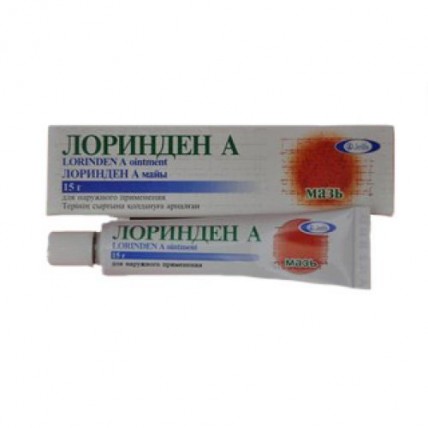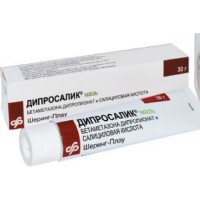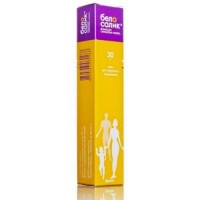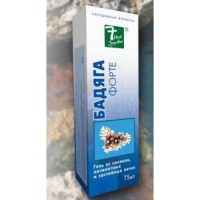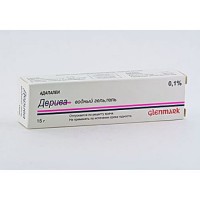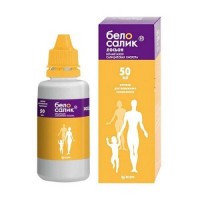Lorinden® A (Flumethasone, Salicylic Acid) 15 g Ointment Tube
- $10.20
Composition
1 g of ointment contains
active substances - flumethasone pivalate 0.2 mg, salicylic acid 30.0 mg,
excipients: propylene glycol, anhydrous lanolin, white petrolatum up to 1 g.
Pharmacological properties
Pharmacokinetics
Flumethasone pivalate easily penetrates into the stratum corneum of the epidermis, where it accumulates. It is not metabolized in the skin. To an insignificant extent, it can enter the body after topical application and have a general effect. After absorption, it is metabolized mainly in the liver. It is excreted in the urine and to a lesser extent in the bile in the form of compounds with glucuronic acid and in small amounts unchanged.
The absorption of flumethasone pivalate through the skin is increased after application to the skin of the axillary and groin areas or to the skin of the face, skin with damaged epidermis or damaged as a result of the inflammatory process. The use of an occlusive dressing, which causes an increase in the temperature and humidity of the skin, also increases the absorption of flumethasone pivalate. In addition, absorption increases with frequent use of the drug or when applied to a large surface of the skin. Absorption through the skin is stronger in young people than in adults.
Salicylic acid has a local effect on the surface of the skin, facilitates the penetration of the glucocorticosteroid through the excessively keratinized epidermis.
Pharmacodynamics
Lorinden® A is a combined preparation, the properties of the ointment are due to the combination of the action of flumethasone pivalate and salicylic acid.
Flumethasone pivalate is a synthetic glucocorticosteroid with a moderate anti-inflammatory effect. Used in an ointment at a concentration of 0.1% has a moderate effect. Possesses lipophilic properties, easily penetrates into the stratum corneum and has anti-inflammatory, antipruritic and anti-allergic effects.
After topical application of flumethasone, pivalate inhibits the formation of prostaglandins and leukotrienes in the skin by interrupting the activity of phospholipase A2 and reducing the release of arachidonic acid from the phospholipids of the cell membrane; phagocytosis, the release of interleukins and other cytokines that cause inflammation, inhibits the release of histamine and the formation of local allergic reactions. Reduces the manifestations of hypersensitivity reactions, proliferative and exudative processes occurring in the connective tissue in the focus of inflammation, reduces hyperemia.
Salicylic acid promotes the penetration of glucocorticosteroids and gives the drug additional antiparakeratotic, moderate keratolytic properties and local hypothermic action, promotes the penetration of flumethasone into the skin. In addition, it has antibacterial and fungicidal properties and restores the protective mantle of the skin.
Indications for use
Lorinden® A in the form of an ointment is applied topically, in particular on an allergic background, not complicated by a secondary bacterial infection, accompanied by hyperkeratosis and persistent itching:
- seborrheic and atopic dermatitis
- urticarial lichen
- allergic contact eczema
- erythema multiforme
- lupus erythematosus
- psoriasis
- lichen planus.
Method of administration and dosage
A small amount of ointment is applied in a thin layer to the affected skin, no more than 1-2 times during the day. With severe lichenization or hyperkeratosis, it is allowed to use an occlusive dressing, which should be changed once a day. Treatment should not be carried out without interruption for more than 2 weeks. Do not use on the face for more than 1 week. Within one week, you can use no more than 15 g of ointment (1 tube).
In children from 2 years of age, use with extreme caution only if necessary, once a day, on a small surface of the skin. Do not apply on the skin of the face, do not apply to children under occlusive dressings.
Side effects
- acne, post-steroid purpura, inhibition of epidermal growth, atrophy of subcutaneous tissue, atrophy of the skin and striae
- dry skin, hypertrichosis or baldness, depigmentation or pigmentation of the skin
- telangiectasia
- perioral dermatitis
- furunculosis, secondary infection
Rarely
- urticaria or maculopapular rash or exacerbation of existing changes
- under an occlusive dressing can cause a resorptive effect in the form of edema, arterial hypertension, a decrease in the body's resistance to infections
- when applied to the skin of the eyelids, glaucoma or cataracts may develop
- when applied to extensive skin surfaces, systemic side effects characteristic of glucocorticosteroids are possible
Contraindications
- hypersensitivity to glucocorticosteroids, salicylic acid and components of the ointment base
- tuberculosis of the skin
- post-vaccination reactions
- bacterial, viral and fungal skin infections
- acne and rosacea
- cutaneous manifestations of syphilis
- skin tumors
- weeping and exudative stages of skin diseases
- chicken pox
- phlebitis (against the background of varicose veins), trophic ulcer
- extensive damage to the skin with a skin defect (burns)
- I trimester of pregnancy
- children's age up to 2 years
Drug interactions
There are no known cases of drug interactions with topical application of glucocorticosteroids.
However, it should be remembered that it is impossible to vaccinate patients against smallpox and other immunizations, especially with prolonged use on a large surface of the skin, given the possibility of the absence of an adequate immunological response in the form of the appearance of appropriate antibodies.
Lorinden® A can enhance the effect of immunosuppressive drugs and weaken the effect of immunostimulating drugs.
Special instructions
Do not use without interruption for more than 2 weeks. With prolonged use on a large surface of the body, the frequency of side effects increases.
With topical application of flumethasone pivalate, a decrease in ACTH production may occur due to inhibition of the pituitary-adrenal system, a decrease in the level of cortisol in the blood and the development of iatrogenic Cushing's syndrome, which disappears after discontinuation of treatment. Periodic monitoring of the function of the adrenal cortex is shown by determining cortisol in the blood and in urine after stimulation of the adrenal glands with ACTH.
If an infection develops at the site of application of the ointment, appropriate antibacterial or antifungal treatment should be carried out. If symptoms of infection persist, the ointment should be discontinued while the infection is being treated.
Avoid the use of the drug on the skin in the eyelids in persons with closed-angle and open-angle glaucoma, as well as in persons with cataracts, given the possibility of intensifying the symptoms of the disease.
On the skin of the face, as well as on the skin of the groin and axillary region, apply only in cases of special need, taking into account the increased absorption and the high risk of side effects (telangiectasia, dermatitis perioralis), even after short use.
Use with caution in the already existing conditions of atrophy of the subcutaneous tissue, especially in the elderly.
Pregnancy and lactation
Lorinden® A can be used in women in the II and III trimesters of pregnancy only when the benefits of use in the mother outweigh the potential risk to the fetus.
It is recommended to be especially careful when using Lorinden® A ointment in breastfeeding women.
If necessary, apply only for a short time to a small surface of the skin, do not apply to the skin of the breast.
Overdose
Symptoms: after prolonged use on a large surface of the skin, the following symptoms may occur: edema, arterial hypertension, decreased resistance to infections, and in severe cases, the development of Cushing's syndrome. Rarely, symptoms of salicylate poisoning may appear.
Treatment: the drug should be gradually discontinued and therapy with a lower glucocorticosteroid content should be used.
Storage conditions
Store at a temperature not exceeding 25oC.
Keep out of the reach of children!
Shelf life 3 years
Do not use after the expiration date.
